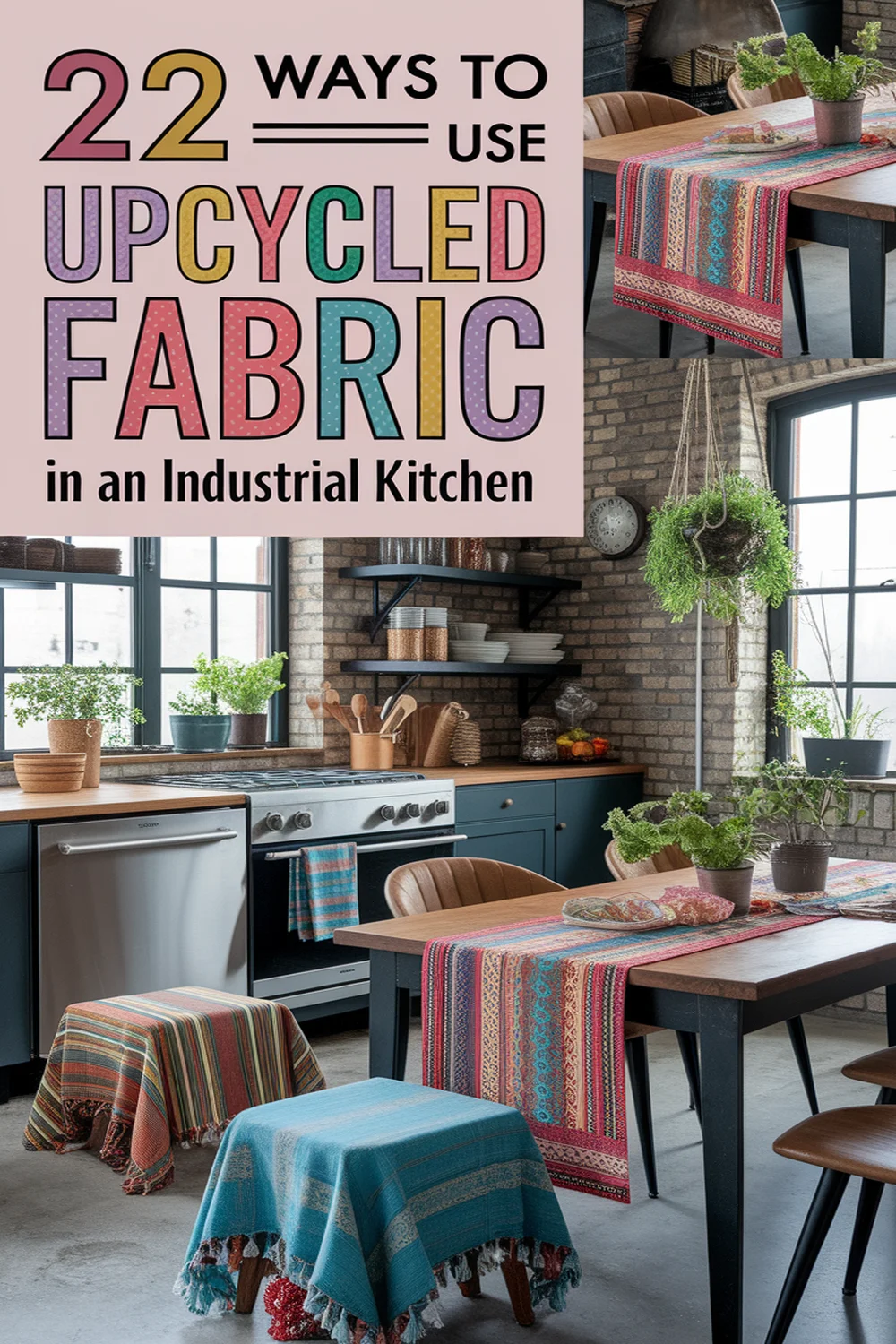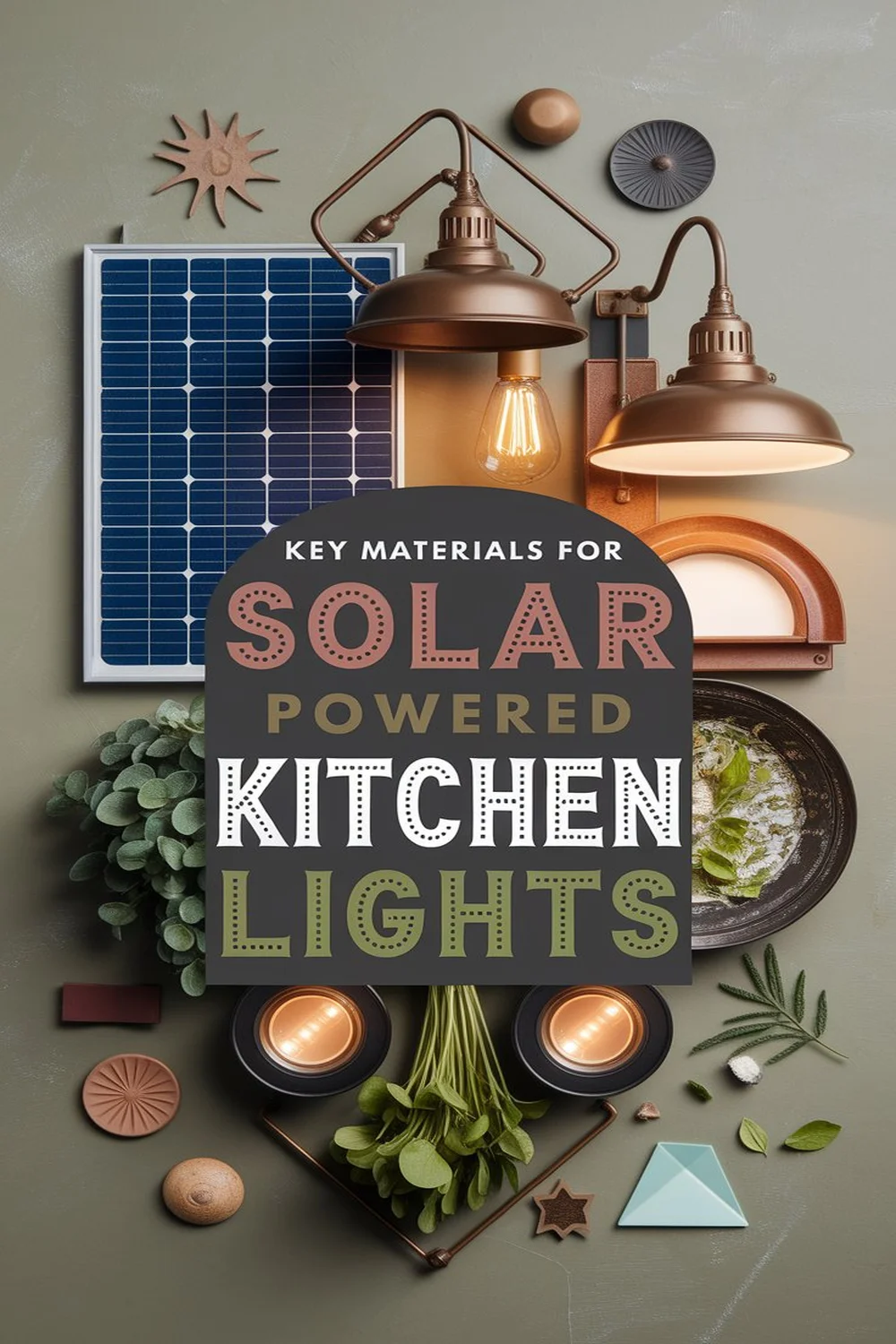This post may contain affiliate links. Please read our policy page.
I love using upcycled fabric to enhance an industrial kitchen. You can make reusable produce bags, kitchen aprons, and pot holders, all while reducing waste. Dish cloths and table runners add practicality and style. Don’t forget about gift wrap, plant hangers, and kitchen curtains to bring charm to your space. Wall pockets keep tools organized and accessible. Keep exploring for more creative ways to transform your kitchen with fabric that’s sustainable and functional!
Reusable Produce Bags

When I think about sustainable practices in industrial kitchens, reusable produce bags come to mind as a simple yet effective solution. These bags help reduce single-use plastic waste while providing a sturdy alternative for storing fruits and vegetables.
I’ve found that using upcycled fabric for these bags not only minimizes material waste but also adds a unique touch to my kitchen. They’re easy to clean, durable, and can be customized in size to fit various produce items.
Using upcycled fabric for reusable produce bags minimizes waste and adds a unique touch to my kitchen.
Plus, they make organizing ingredients more efficient. By incorporating reusable produce bags into my kitchen routine, I’m taking a step toward sustainability and encouraging others to do the same.
It’s a small change that can lead to a big impact on our environment.
2. Kitchen Aprons
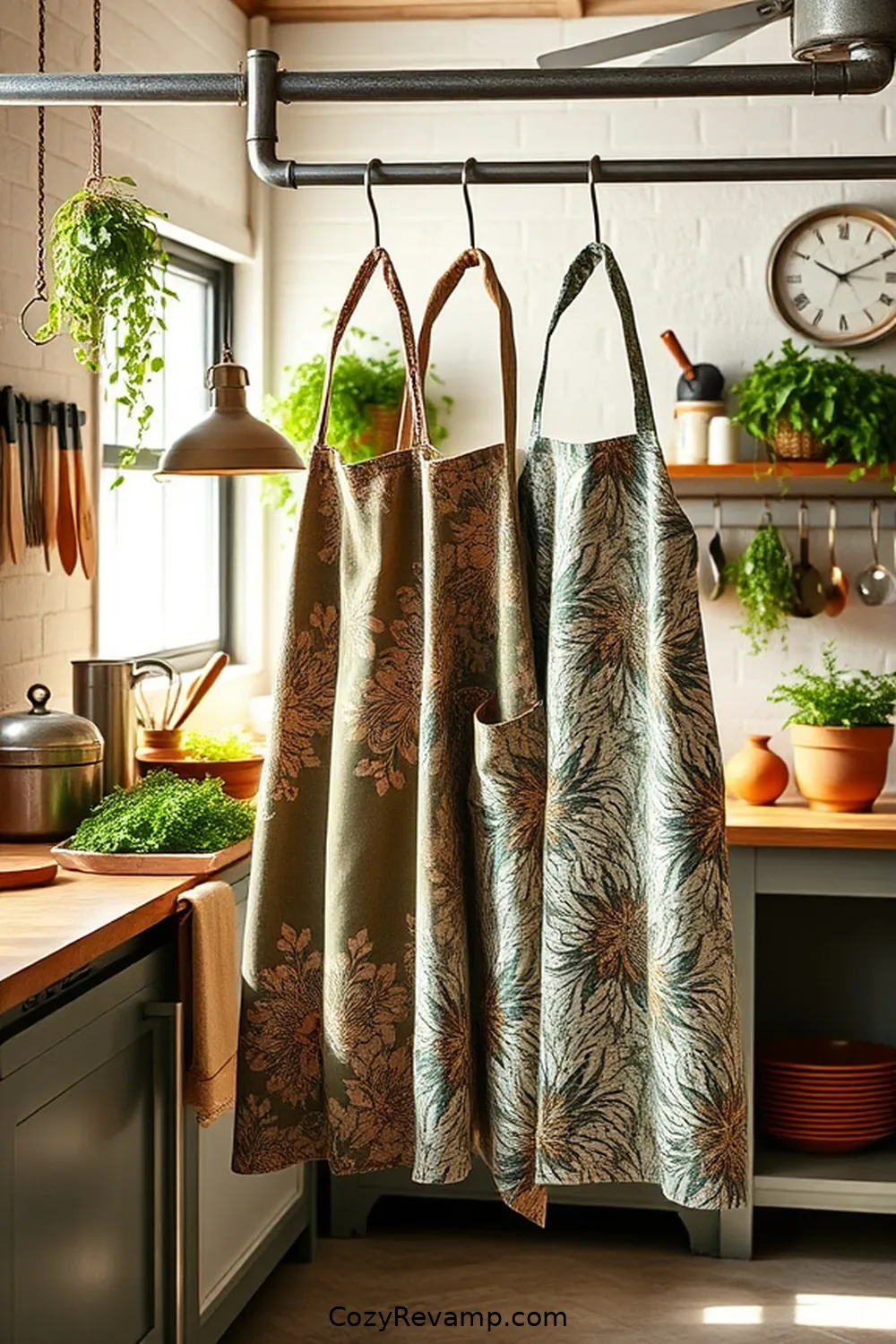
While preparing meals in an industrial kitchen, I’ve come to appreciate the importance of a sturdy kitchen apron. They protect my clothing from spills and splatters, but they also offer practical benefits.
Upcycled fabric is a fantastic choice for creating durable aprons that are both functional and eco-friendly.
Here are three ways I use upcycled fabric for kitchen aprons:
- Layering: I combine different fabric types for added durability and unique designs.
- Pockets: I sew in pockets from old clothing, providing handy storage for tools and utensils.
- Adjustable Straps: I repurpose straps from other garments, ensuring a comfortable fit for anyone using the apron.
Using upcycled materials not only saves resources but also adds character to my kitchen attire.
3. Pot Holders

After mastering the art of crafting durable kitchen aprons, I turned my attention to another essential kitchen accessory: pot holders.
These handy items protect my hands from burns and spills while adding a splash of color to my kitchen. Using upcycled fabric, I cut squares or rectangles, ensuring they’re thick enough to provide insulation.
Pot holders offer essential protection from burns while brightening up my kitchen with vibrant, upcycled fabric designs.
I often layer two pieces of fabric with a heat-resistant batting in between for extra protection. Stitching around the edges not only secures the layers but also gives them a polished finish.
I love personalizing them with unique patterns or vibrant colors, making each pot holder a functional piece of art. With a little creativity, I can easily integrate sustainability into my cooking space.
4. Dish Cloths
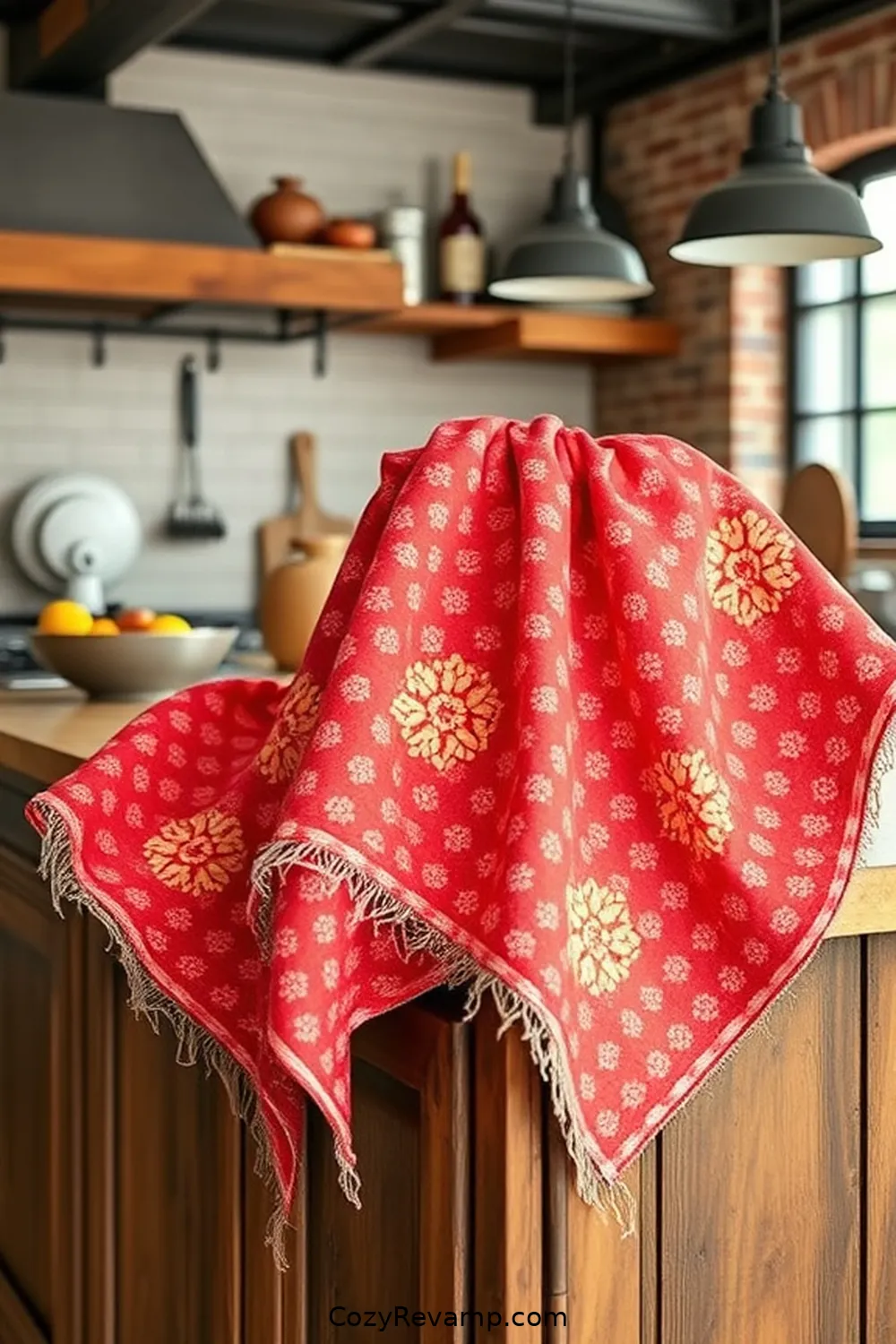
Although I’ve enjoyed making pot holders, I find dish cloths to be just as essential in my kitchen toolkit. They’re versatile, practical, and perfect for upcycling fabric scraps.
Here are three ways I use my upcycled dish cloths:
- Wiping Surfaces: I keep them handy for quick clean-ups on counters and tables.
- Drying Dishes: They’re great for drying glassware and utensils without leaving lint behind.
- Mopping Up Spills: I always grab one when accidents happen; they absorb spills quickly and can be tossed in the wash afterward.
Creating these dish cloths not only reduces waste but also adds a personal touch to my kitchen.
Plus, they’re easy to make and customizable!
5. Table Runners
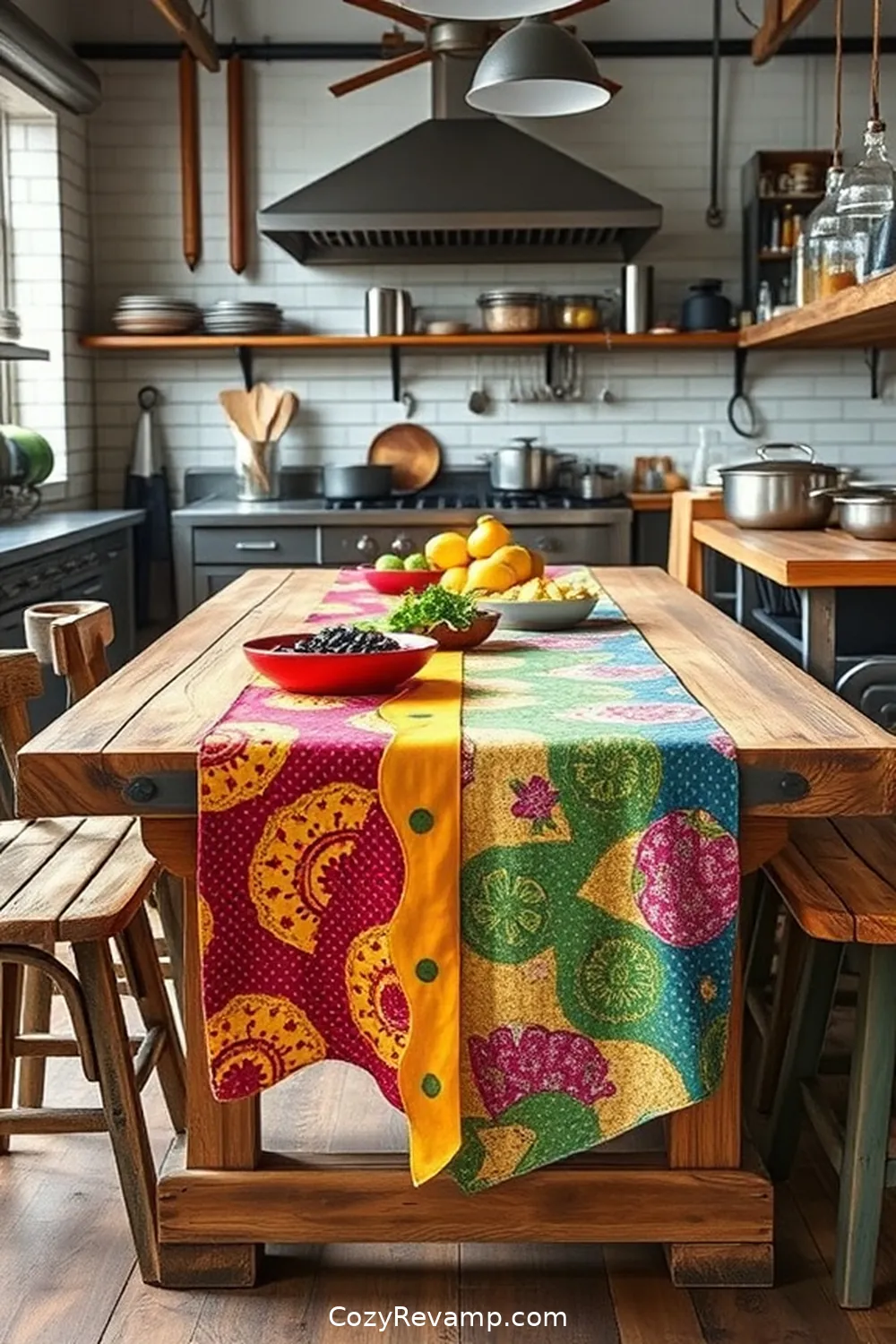
Creating table runners from upcycled fabric not only enhances my dining experience but also showcases my commitment to sustainability. I love transforming old textiles into beautiful, functional pieces that add character to my kitchen.
First, I choose fabrics with interesting patterns or textures, like remnants from previous projects or thrifted finds. After measuring my table, I cut the fabric to size, ensuring it’s long enough to drape over the edges. I often sew or simply hem the edges to prevent fraying.
These runners not only protect my tables but also serve as conversation starters. Plus, I can easily switch them out for different occasions, keeping my dining space fresh and inviting while reducing waste. It’s a win-win!
6. Oven Mitts
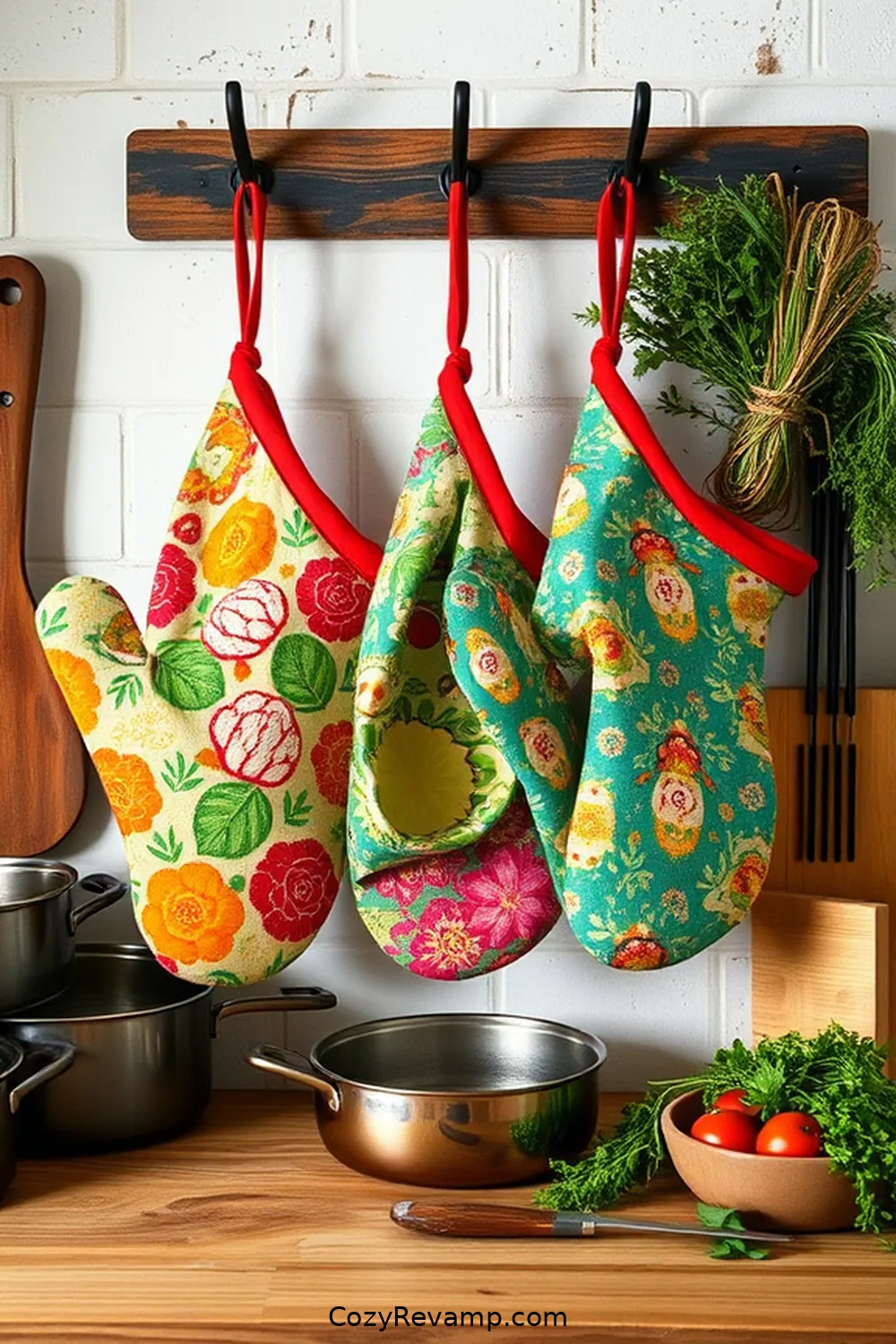
When I decided to make oven mitts from upcycled fabric, I found it to be a rewarding way to merge functionality with eco-friendliness. Not only do these mitts protect my hands, but they also add a unique touch to my kitchen.
Here’s what I did to create them:
- Choose durable fabrics: I used old jeans, cotton scraps, and even tablecloths for their sturdiness.
- Add insulation: I included layers of heat-resistant material to guarantee safety while handling hot pots and pans.
- Personalize: I stitched on fun patterns or colors, making each mitt one-of-a-kind.
These oven mitts not only serve a purpose but also reflect my commitment to sustainable practices in the kitchen.
Recommended Items
Check out our curated selection of products and equipment to help you creatively use upcycled fabric in your industrial kitchen!
Products
7. Fabric Food Covers

After making oven mitts, I realized that fabric can also play an essential role in reducing waste during food storage.
Fabric food covers are a fantastic way to keep leftovers fresh while minimizing reliance on plastic. I’ve started using upcycled fabric scraps to create these covers, and they’re both functional and attractive.
Fabric food covers are a stylish and sustainable solution for keeping leftovers fresh while reducing plastic waste.
Just cut the fabric into various sizes, hem the edges, and add an elastic band for a snug fit. They’re perfect for bowls, plates, and even larger containers. Not only do they breathe better than plastic, but they also add a personal touch to my kitchen.
Plus, they’re washable and reusable, making them an eco-friendly choice that aligns perfectly with my commitment to sustainability.
Task Overview for Upcycled Fabric Decor
8. Cutting Board Mats
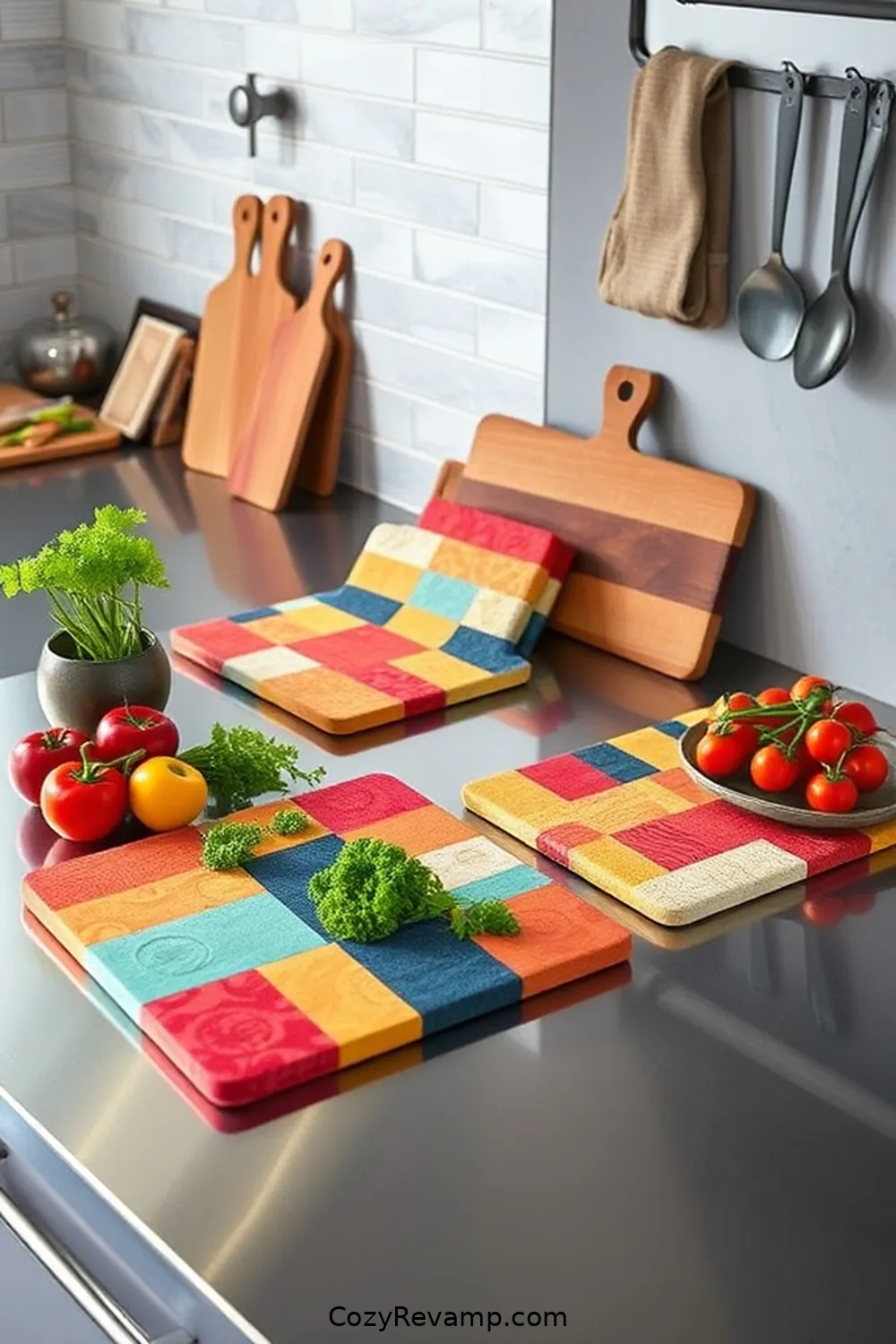
While preparing meals in my kitchen, I found that cutting board mats made from upcycled fabric can considerably enhance food preparation.
These mats not only protect my countertops but also add a touch of creativity to my space.
Here are three benefits I’ve discovered:
- Non-slip surface: The texture of upcycled fabric provides a stable grip, reducing the risk of slipping while chopping.
- Easy to clean: After using, I can simply toss them in the wash, ensuring hygiene and saving time.
- Eco-friendly choice: Using materials that would otherwise go to waste aligns with my commitment to sustainability.
Incorporating cutting board mats into my kitchen routine has made meal prep more enjoyable and efficient.
Plus, it’s a small step towards a greener kitchen!
9. Storage Baskets

Though my kitchen may be small, upcycled fabric storage baskets have become essential for keeping it organized and stylish. I use these baskets to sort everything from spices to snacks, making it easy to grab what I need while cooking. The vibrant colors and patterns add a personal touch to my space, transforming it into a cozy hub.
Creating these baskets is simple. I often repurpose old fabric scraps or worn-out textiles, sewing them into various sizes to fit my storage needs. They’re lightweight, easy to clean, and can be customized to match my kitchen decor.
Plus, using upcycled materials is an eco-friendly choice that reduces waste. Overall, these baskets have truly made my kitchen more functional and visually appealing.
10. Utensil Holders
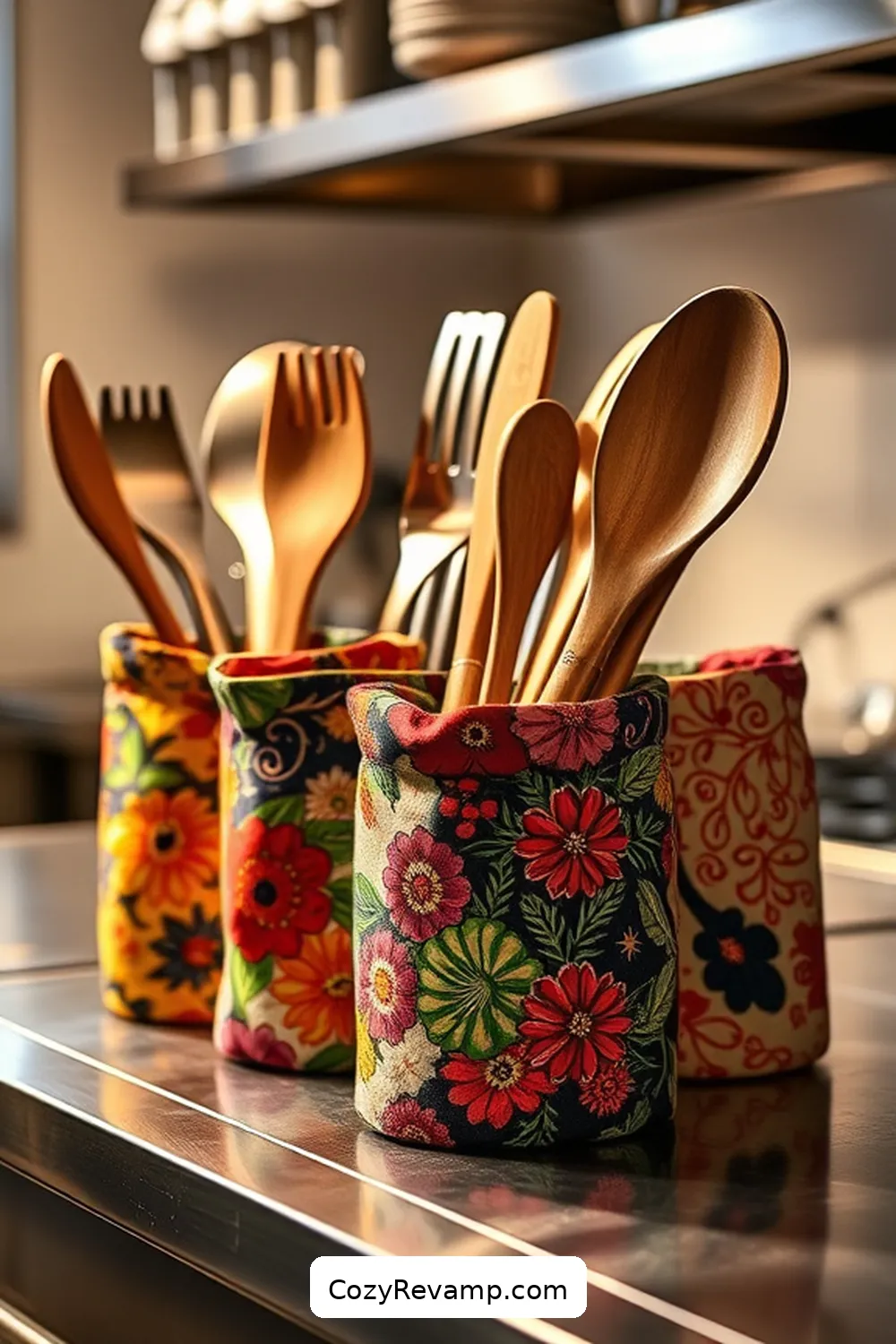
Storage baskets aren’t the only way to bring organization to my kitchen. Utensil holders made from upcycled fabric can add both style and functionality to my workspace.
I love how I can customize them to fit my kitchen’s aesthetic while being eco-friendly. Here are three simple ideas for creating utensil holders:
- Mason Jar Covers: Use fabric scraps to cover mason jars, giving them a charming, rustic look.
- Hanging Pockets: Sew small fabric pockets to hang on a wall, perfect for storing spatulas and spoons.
- Fabric Baskets: Create soft-sided baskets that can hold larger utensils, keeping everything within easy reach.
These holders not only reduce clutter but also showcase my creativity with upcycled materials!
11. Recipe Cards or Holders

Creating recipe cards or holders from upcycled fabric is a fantastic way to keep my favorite recipes organized and accessible. I love using vibrant fabric scraps to make unique, durable cards that not only look great but also withstand the kitchen’s hustle.
Here’s a simple table to help you visualize the process:
| Step | Description |
|---|---|
| Choose Fabric | Select colorful, durable scraps |
| Cut to Size | Trim fabric into desired card size |
| Add Details | Write recipes or use fabric markers |
12. Snack Bags
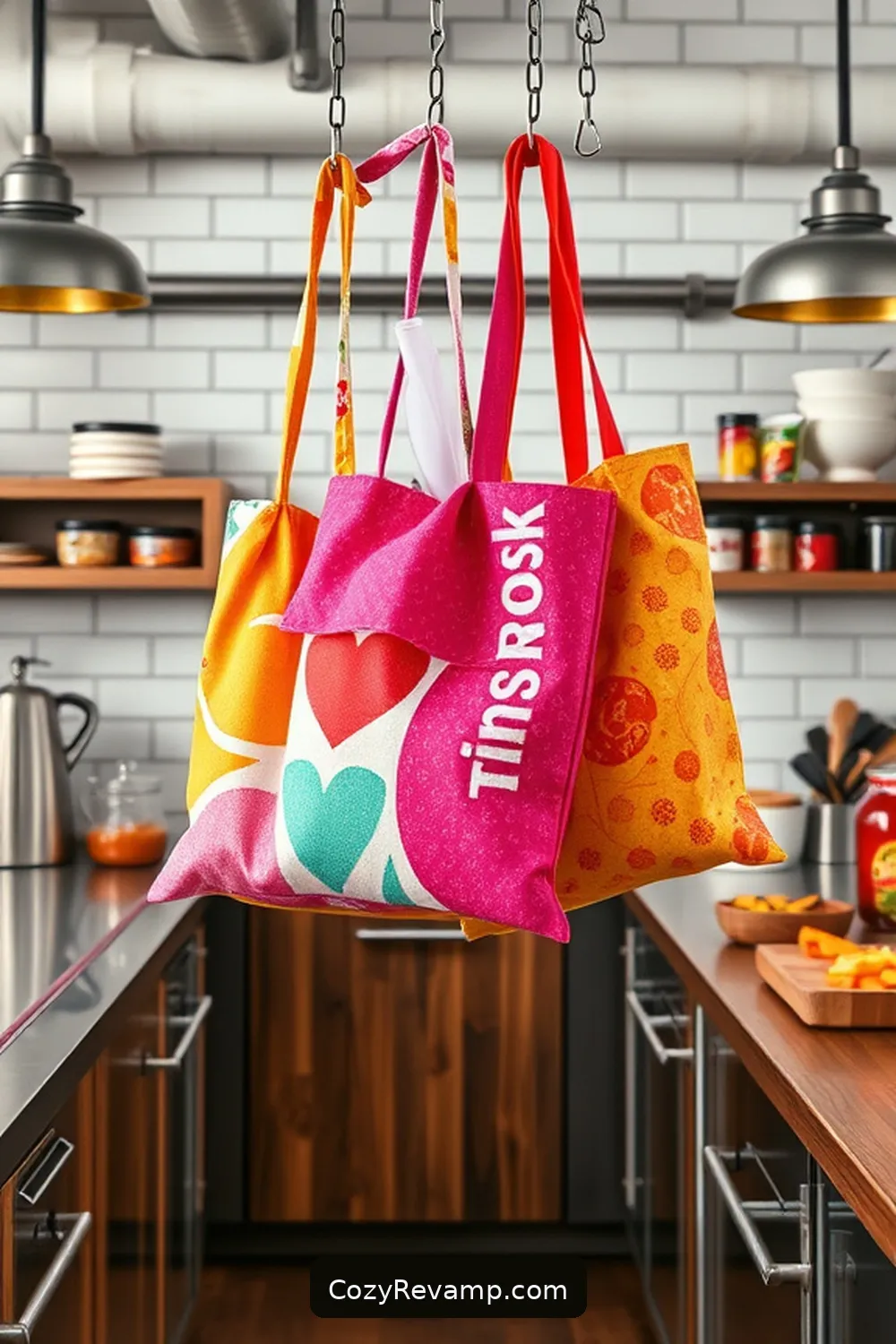
Snack bags made from upcycled fabric are an eco-friendly solution for on-the-go snacking.
I love how they not only reduce waste but also add a personal touch to meal prep.
Here are three practical ways I use these snack bags in my industrial kitchen:
- Portion Control: I fill them with pre-measured snacks like nuts or granola, making it easy for staff to grab a healthy bite without overindulging.
- Dry Ingredients: These bags are perfect for storing dry ingredients, like herbs or spices, keeping them fresh and easy to access during busy shifts.
- Leftovers: I use them to store leftover ingredients, reducing food waste and ensuring nothing goes to waste.
These simple swaps make a big difference in sustainability!
13. Bar Towels
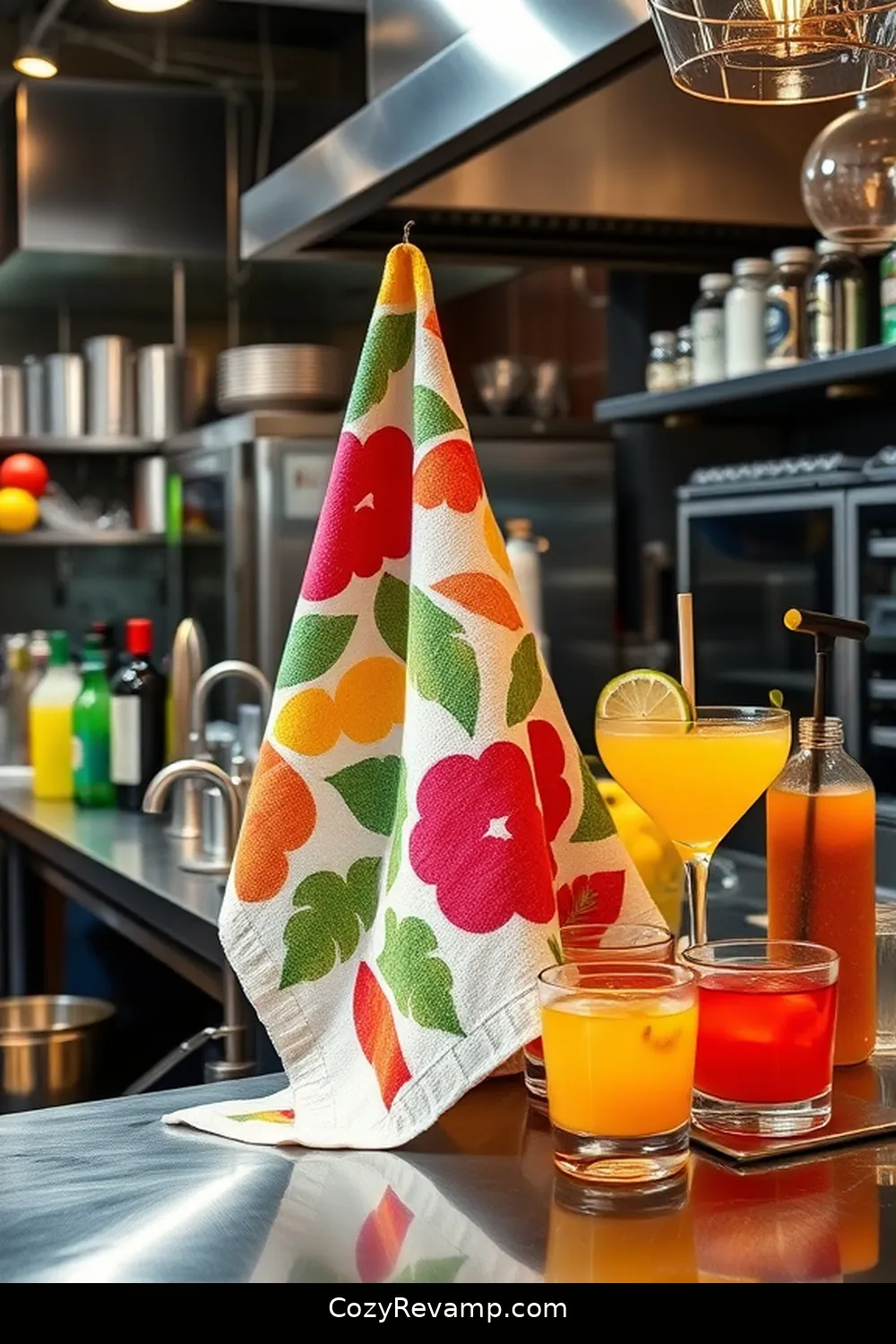
Bar towels are essential in my industrial kitchen, especially when made from upcycled fabric. They’re not just practical; they’re also a sustainable choice that helps reduce waste.
I use these towels for everything from drying dishes to wiping down surfaces. The absorbency of upcycled materials often surpasses traditional towels, making them perfect for heavy-duty tasks.
To create my bar towels, I repurpose old shirts or linens, cutting them into manageable sizes. This way, I can customize the thickness and absorbency based on my needs.
Repurposing old shirts and linens into bar towels lets me customize thickness and absorbency for my kitchen needs.
Plus, the unique patterns add character to my kitchen. By using upcycled fabric for bar towels, I save money and contribute positively to the environment while maintaining a clean and efficient workspace.
14. Chair Cushions
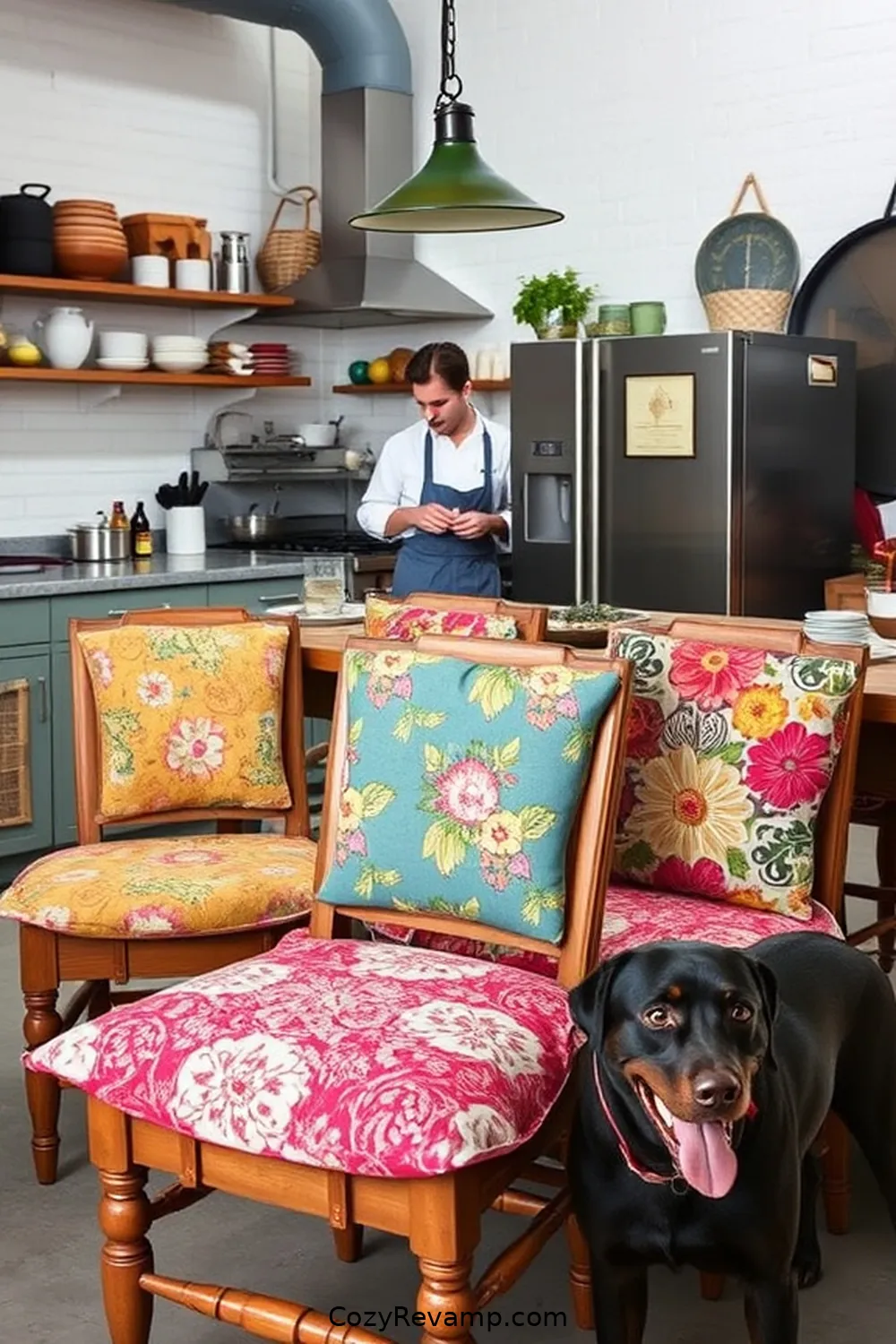
Chair cushions play an essential role in enhancing comfort during long hours spent in the kitchen.
Using upcycled fabric for these cushions can’t only save money but also add a unique flair to your space.
Here are three practical ideas for creating chair cushions from upcycled materials:
- Old Denim: Transform worn-out jeans into durable and stylish cushions. The thick fabric provides excellent support.
- Vintage Tablecloths: Repurpose colorful tablecloths for a nostalgic touch. They’re often large enough to cover multiple cushions.
- Fabric Scraps: Sew together various fabric scraps for a fun, patchwork design. This is a creative way to minimize waste.
15. Wall Art
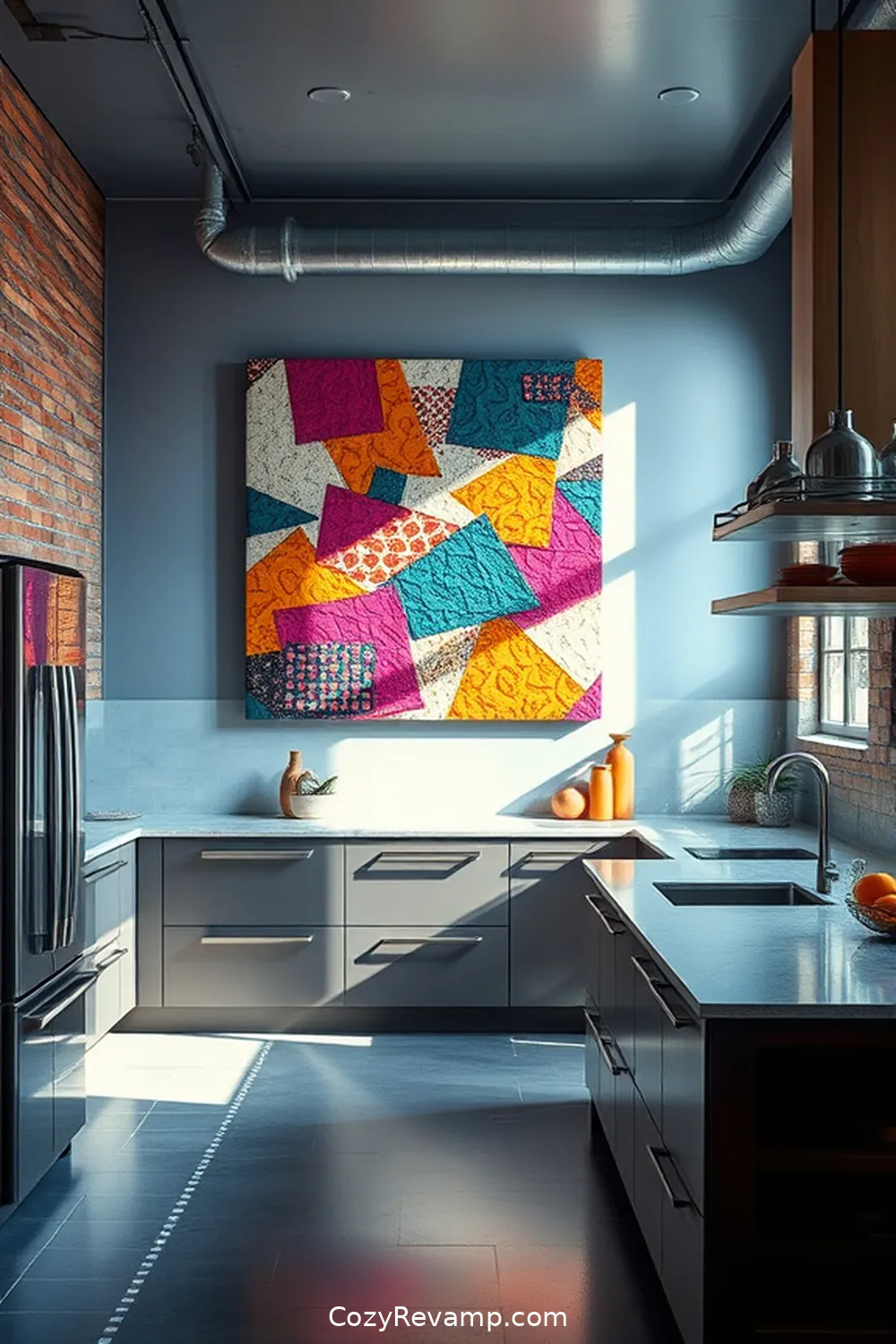
After upgrading your chair cushions, consider how wall art can further personalize your industrial kitchen. Upcycled fabric offers a unique way to create stunning artwork that reflects your style. You can make wall hangings, framed fabric pieces, or even fabric collages. It’s a fantastic way to showcase your creativity while being eco-friendly.
Here’s a quick guide to get you started:
| Fabric Type | Ideal Use |
|---|---|
| Denim | Wall hangings |
| Cotton Prints | Framed art pieces |
| Burlap | Rustic collages |
Using these materials not only adds character but also sparks conversation among guests. So, grab those fabric scraps and let your kitchen walls tell a story!
16. Fabric Napkins
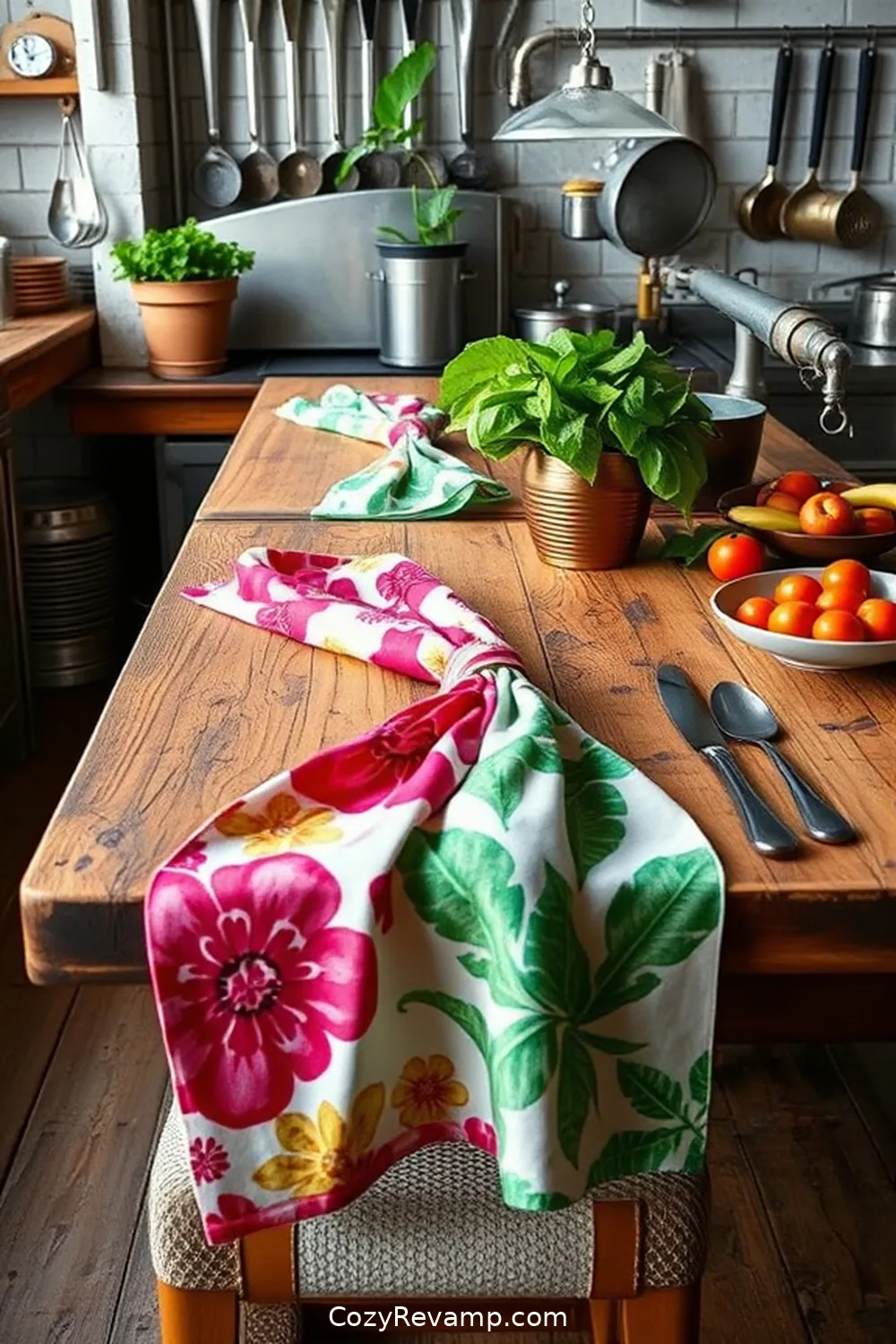
Fabric napkins can elevate your dining experience in an industrial kitchen while being eco-friendly.
I love using upcycled fabric for napkins because they add a unique touch and reduce waste. Here are three practical ideas for incorporating them:
- Color Coordination: Choose fabrics that match your kitchen’s color scheme or theme. It creates a cohesive look that impresses your guests.
- Custom Sizes: Cut napkins to various sizes depending on your needs. Smaller ones work well for appetizers, while larger napkins are great for main courses.
- Personalization: Get creative by adding embroidered initials or fun patterns. It’s a simple way to make your dining experience feel special.
Using fabric napkins not only enhances presentation but also supports sustainability in your kitchen!
17. Ingredient Labels
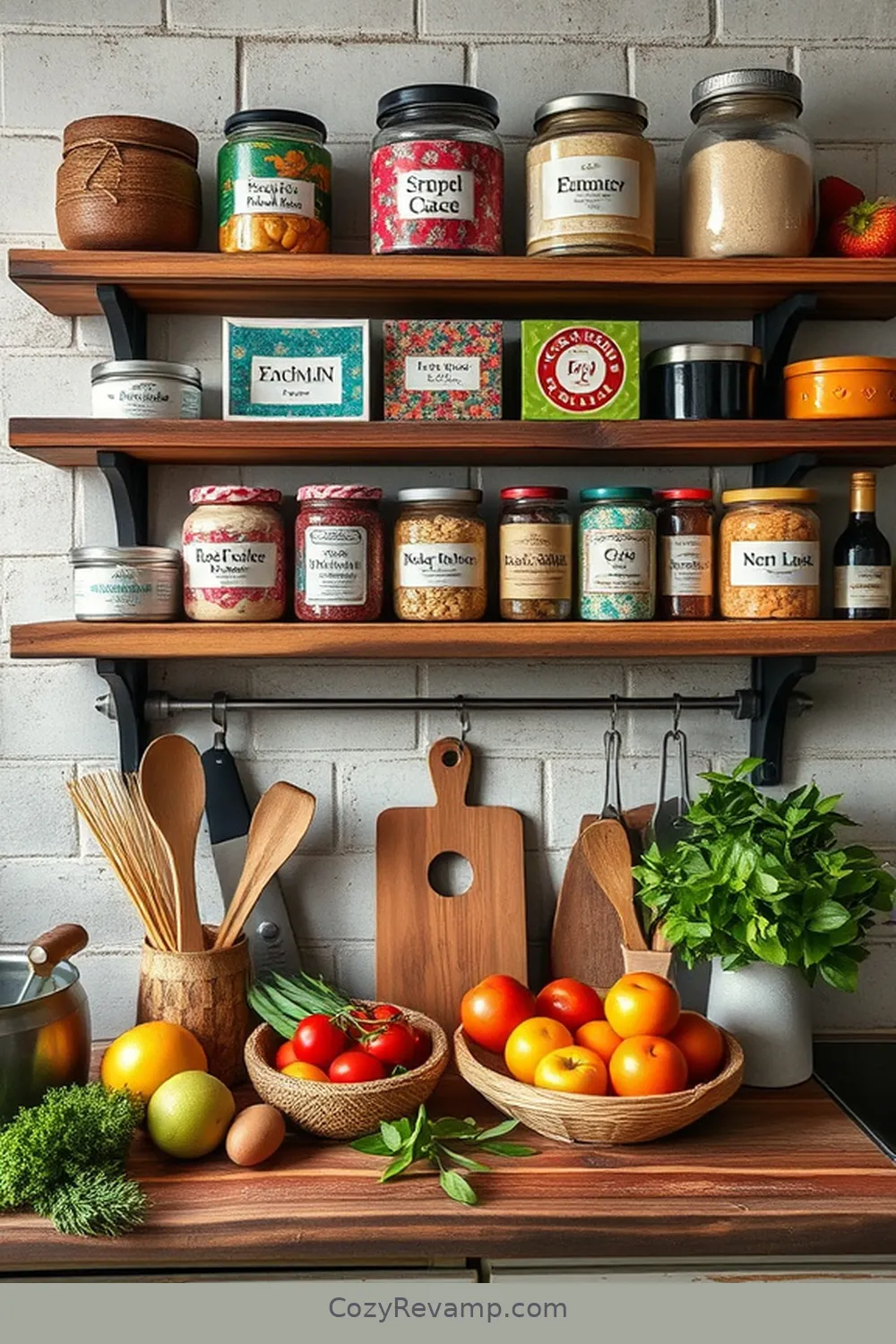
Ingredient labels are essential for any industrial kitchen, ensuring clarity and transparency in what goes into each dish. I always prioritize using upcycled fabric for creating these labels. It’s a sustainable choice that minimizes waste while still providing a professional appearance.
I cut small rectangles from fabric remnants and write the ingredient names with a fabric marker. This method not only reduces my environmental footprint but also adds a unique touch to my kitchen. I attach the labels to jars and containers with a simple twine or clip, making it easy to identify contents at a glance.
Plus, the labels hold up well under various kitchen conditions, ensuring they remain readable and functional over time.
18. Pantry Organizers
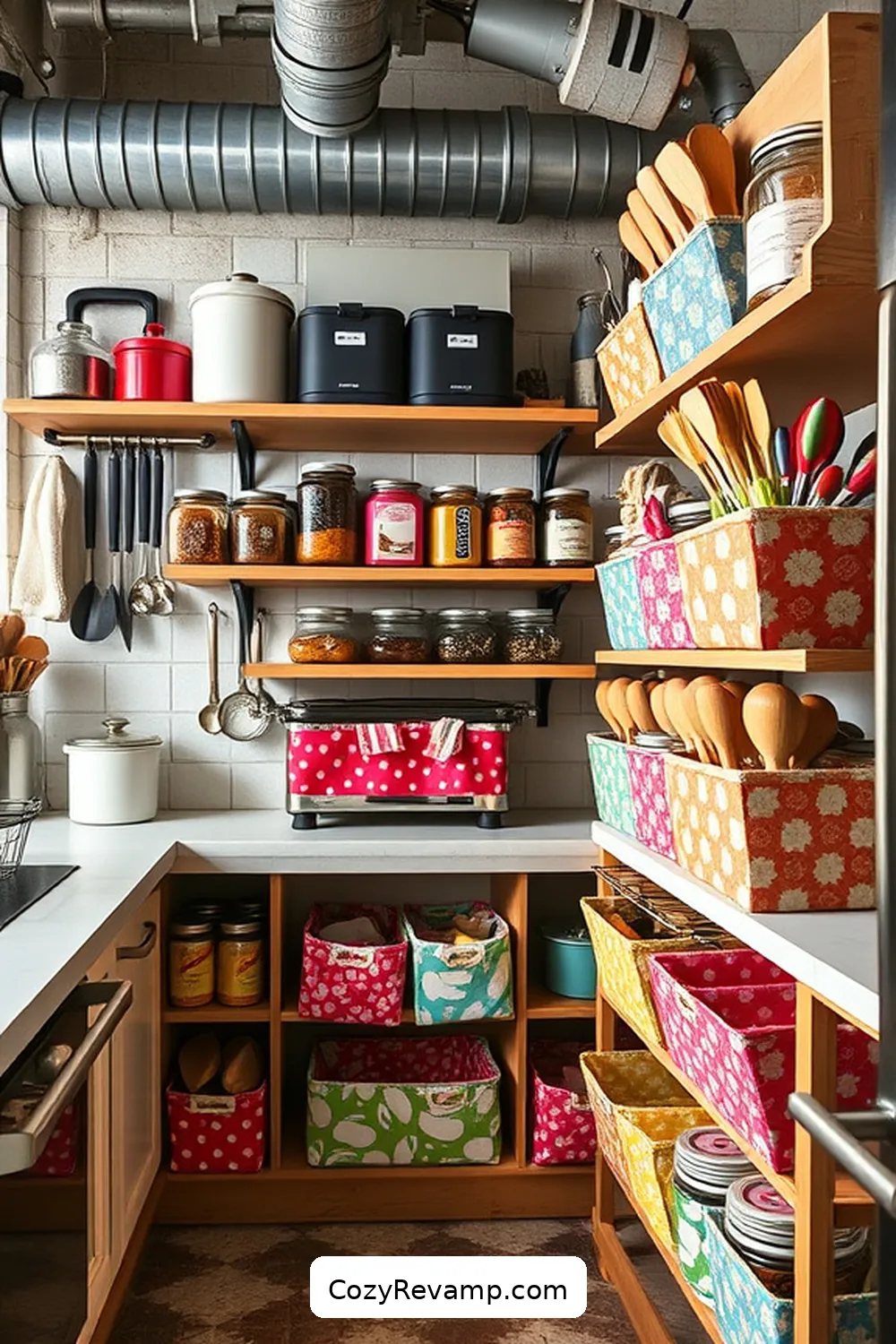
While organizing a pantry might seem like a mundane task, I find that using upcycled fabric for pantry organizers can make a significant difference.
Using upcycled fabric for pantry organizers transforms a mundane task into a creative and eco-friendly endeavor.
Not only does it help reduce waste, but it also adds a personal touch to my kitchen. Here are three practical ideas for pantry organizers using upcycled fabric:
- Fabric Bins: Sew small bins from old tablecloths or shirts to store snacks or dry goods, keeping everything tidy and accessible.
- Hanging Pockets: Create wall-mounted pockets from fabric scraps for spices or utensils, saving counter space and adding color to the walls.
- Wraps for Jars: Use fabric remnants to wrap jars, adding a decorative element while keeping contents labeled and organized.
These simple projects have transformed my pantry into a functional and stylish space!
19. Gift Wrap
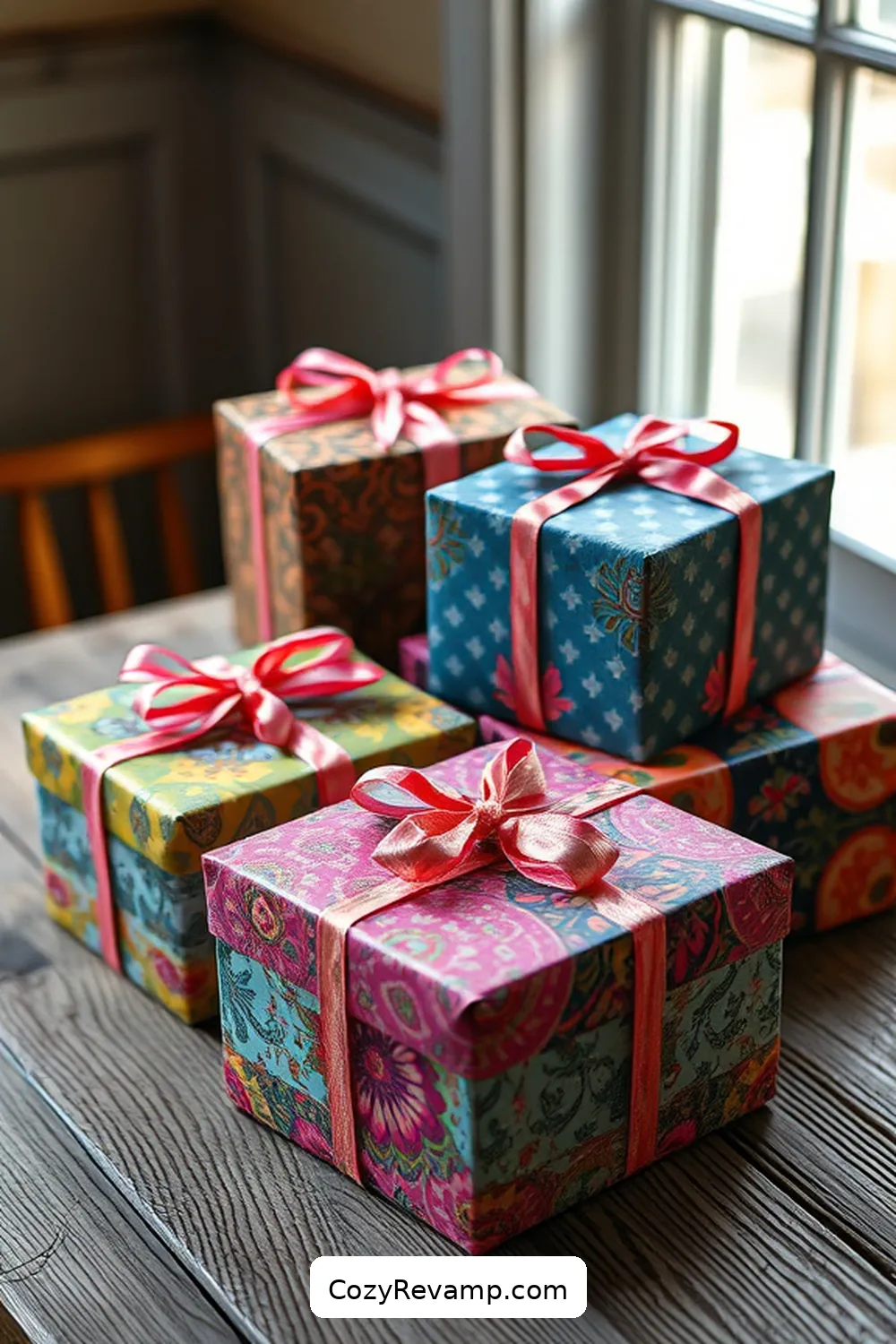
When it comes to gift wrap, using upcycled fabric not only elevates your presents but also contributes to a more sustainable approach to gifting. I love the idea of wrapping gifts in unique fabric pieces that tell a story. It adds a personal touch that paper simply can’t match.
Here’s a quick guide on fabric options, sizes, and best uses:
| Fabric Type | Size (inches) | Best For |
|---|---|---|
| Cotton remnants | 18×18 | Small gifts |
| Linen scraps | 24×24 | Medium gifts |
| Denim pieces | 36×36 | Large gifts |
20. Plant Hangers
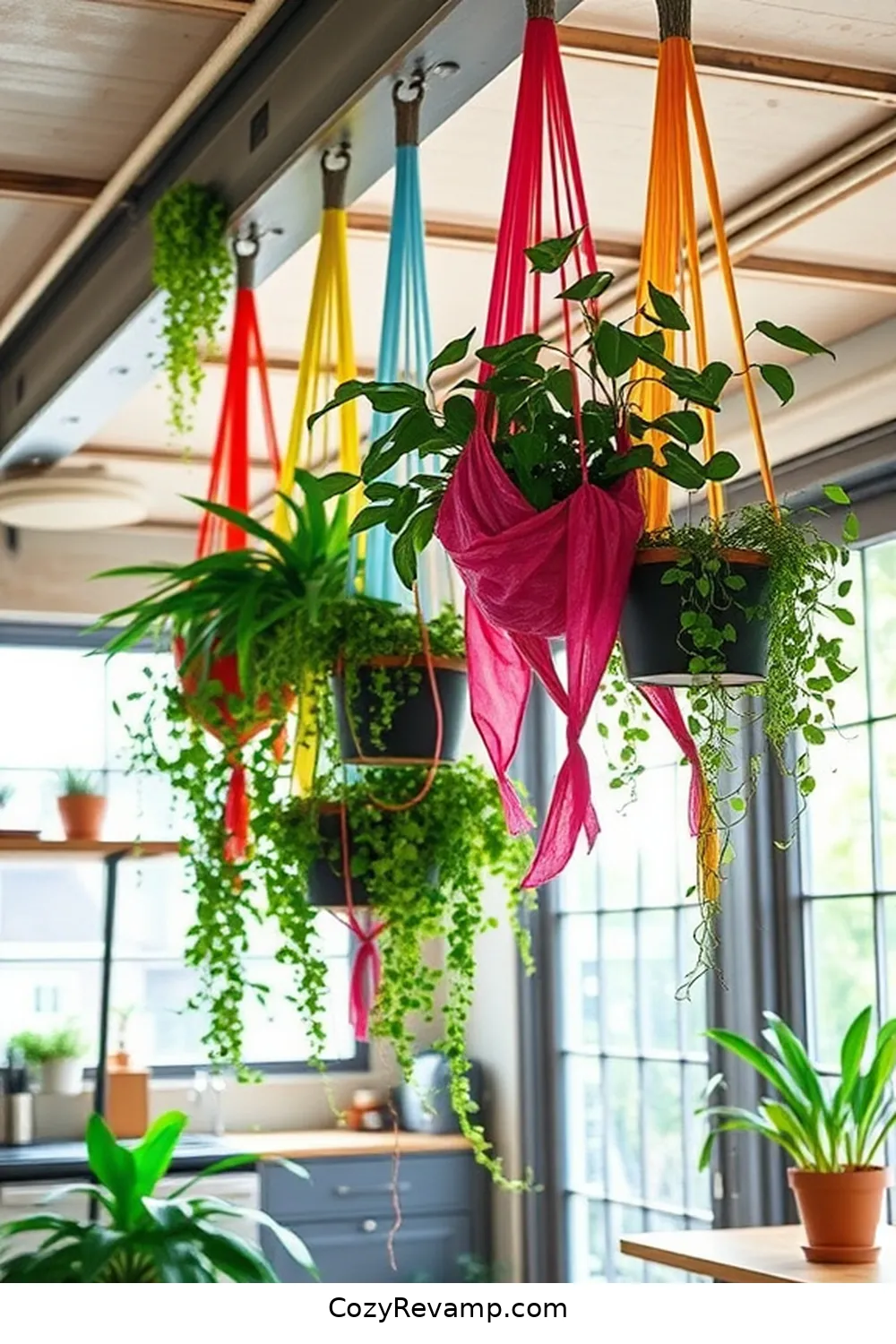
Upcycling fabric can extend beyond gift wrap; it’s also a fantastic way to create unique plant hangers.
Transforming leftover fabric into distinctive plant hangers is a delightful way to reduce waste and enhance your kitchen’s charm.
I’ve found that using leftover fabric not only reduces waste but also adds character to my kitchen.
Here are three ideas to get you started:
- Braided Hangers: Cut strips of fabric and braid them together for a sturdy, colorful hanger.
- Knotted Styles: Use long fabric strips to create a simple knotted design that supports your plants elegantly.
- Sewn Pockets: Sew fabric into pockets for small potted plants, allowing them to hang and display beautifully.
These plant hangers not only save resources but also brighten up any kitchen space.
Let’s get creative and make our kitchens greener!
21. Kitchen Curtains
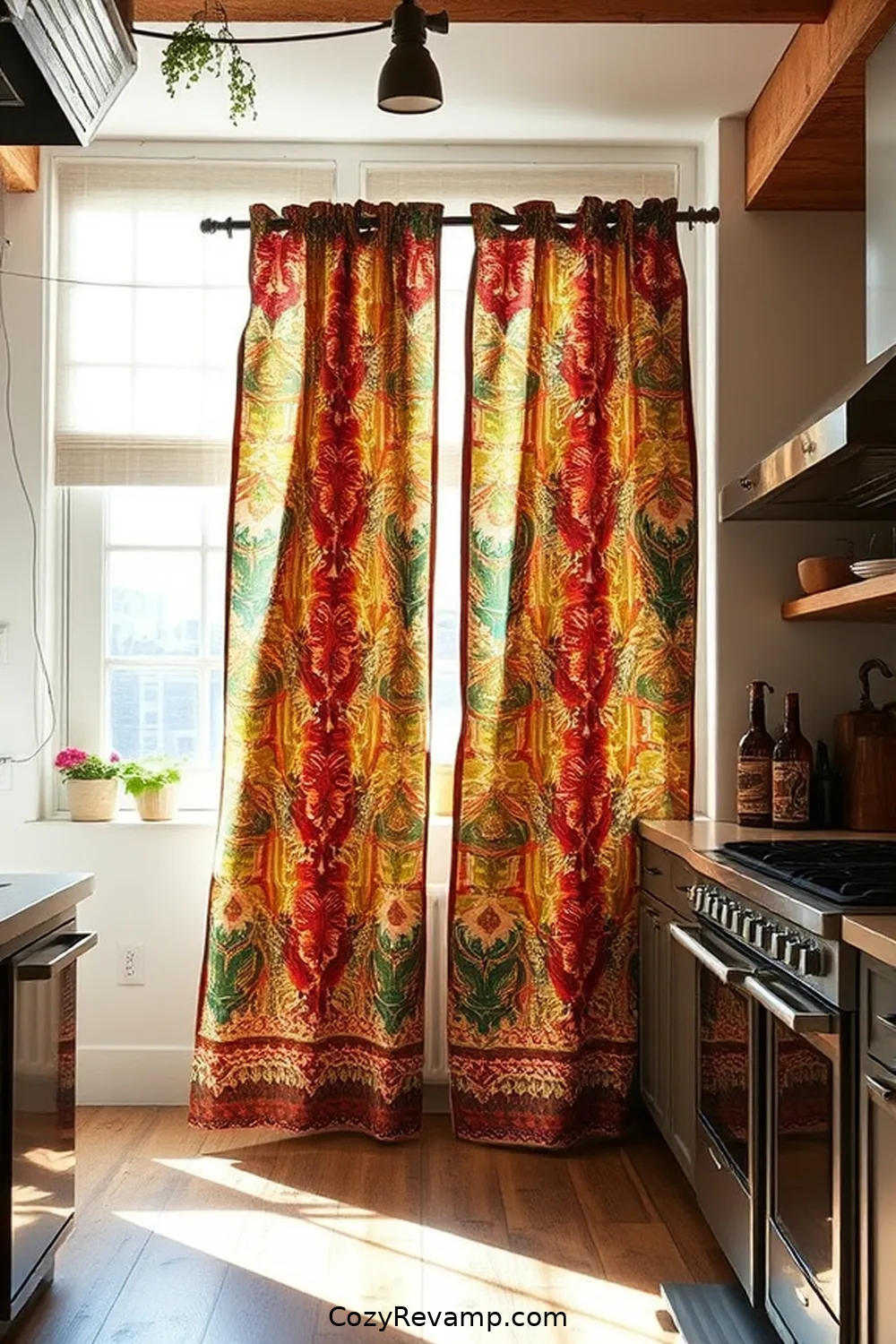
Transforming your kitchen with upcycled fabric curtains can bring both style and sustainability to the space. I love using remnants from old tablecloths or fabric scraps to create unique, eye-catching curtains. It’s a practical way to reduce waste while adding a personal touch to your kitchen.
First, measure your window to determine how much fabric you’ll need. Then, I usually cut the fabric to size, leaving a bit extra for hems. You can either sew or use fabric glue for a no-sew option.
Don’t forget to choose a fun pattern or color that complements your decor!
Finally, hang your curtains using simple rods or clips. With just a little effort, you’ll have beautiful, eco-friendly curtains that brighten your kitchen.
22. Wall Pockets for Tools
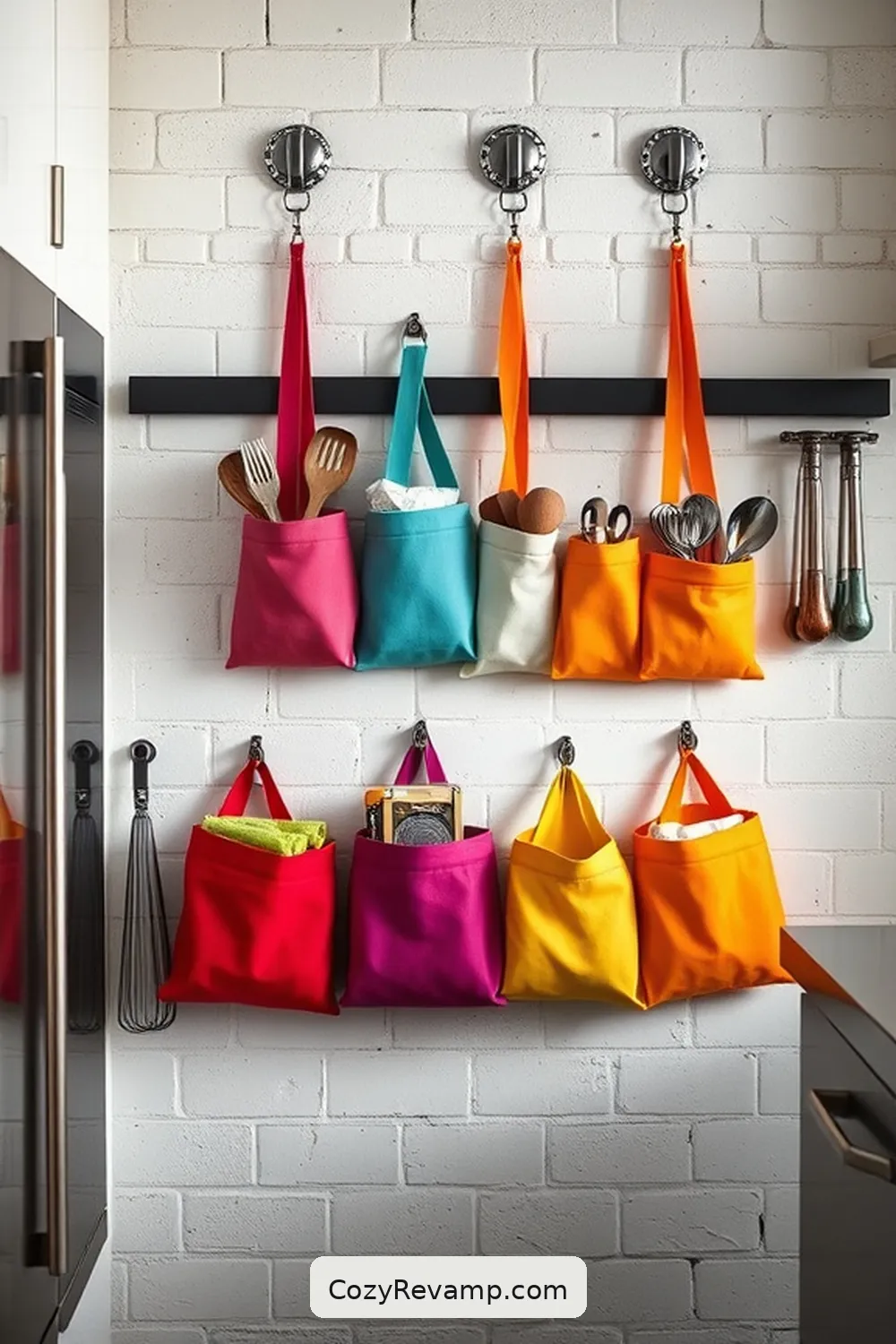
Wall pockets for tools are a fantastic way to keep your kitchen organized while utilizing upcycled fabric.
I love how these pockets help declutter my workspace, making tools easily accessible. Plus, they look great hanging on the wall!
Here are three items you can easily store in these pockets:
- Cutting tools – Keep knives and spatulas handy without taking up counter space.
- Measuring cups – Store these essentials in a designated pocket for quick access during prep.
- Towels – Hang dish towels or cloths for easy drying and cleaning.
Creating wall pockets from fabric scraps not only saves resources but also adds a personal touch to your kitchen.
Let’s make our cooking space functional and stylish!

